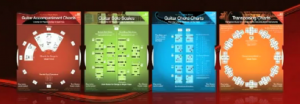Today, we’ll learn how to play music by ear intrinsically.
Hi, it’s Ron Greene here,
awhile ago we discussed how music theory, and how you might discover some insightful ways to play better on your musical instrument. Also, I provided you with a blurb about my development experiences with the Music Dial.
Within this posting I’d love to discuss some thoughts with you, regarding your ability and feelings about… playing music by ear.
Here’s my take on playing music by ear or “play by ear” if you will. It might reference a typical means of playing music without wanting or needing to read notes on a music staff or on a tablature. The ability to play by ear, no doubt, means a lot of different things to a lot of people. To me it seems that on many occasions, playing music by ear would be a practical thing to learn and do.
Let’s say you hear a song on the radio that you’d like to learn immediately, but you don’t want to get references from the song sheets or tablatures. You’d just like to start playing that song right away… “playing it by ear”.
Or, you might be a songwriter that’s just looking to put together an interesting chord and melody structure for a song you have in mind. Even in a living room jam situation with other musicians, there are lots of examples where playing by ear would be a helpful skill. In any case… you’d just like to start playing song(s) right away!
Learning music by ear is referenced by repeatedly listening to the song(s) and then recreate what one hears. Mentally hearing rhythms and pitches is the skill of reproducing sounds involving… melody, harmony (chords) and bass lines.
Playing by ear enhances your abilities to improvise solos on the guitar and keyboard. This is how musicians learn songs when there is no available musical notation. Many players still learn to play by ear with ear training.
All songs are played in a key. Most songs for most styles can be played using just 8 chords for accompaniment and 6 scales for melodies or solos in each key. Except for jazz, most songs use only major, minor and seventh chords and these are the basic chords you’ll discover in each key. By experimenting and having fun playing, creating or improvising great sounding chord progressions in each key, your ‘play by ear’ knowledge will immediately expand.
It’s important to learn what an interval sounds like. An interval is simply the space between two notes. Once you learn what each of these intervals sound like you can reproduce a melody. And then, chords structures will come naturally thereafter.
The shape of the tune, “melody”… how to form the chords, “chord structure”… and the path the chords take as they weave through-out a piece, “chord progressions” – are the essential elements of any song structure.
When playing by ear, a musician doesn’t necessarily have all of the ‘key’ chords and scale structures committed to memory. Music Dial Charts provide a concise, effective representation of the best sounding chords along with the best sounding notes in each key. As a movable device, one simply turns the dial to the key for that song and immediately at-a-glance, it provides the chords and scales required.
Open the door to a whole new level of musical mastery by discovering how to play by ear!
https://www.MusicDials.com
Contact: Ron Greene – Music Dial Charts
P.O. Box 388 *Durango, CO. 81302 / USA
ron@frontier.net
phone: 970-259-5214

